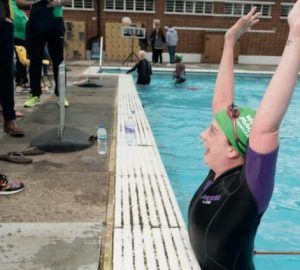Why I’m not planning an Ice Mile
If you’re involved in open water swimming, you can’t help but notice the growing popularity of cold water swimming. In the UK, we had an event at Parliament Hill Lido last weekend, there is another at Tooting Bec next weekend and a third in Windermere the weekend afterwards. Then, if you spend any time on Facebook, you’ll see plenty of people posting pictures and videos of chilly winter swims.
Mostly this is a good thing. The majority of cold water swimmers are sensible (sort of), know their limits, treat the water with respect and generally have a fun time.
Being human however, we like to test ourselves: how fast can we swim, how far can we swim and (recently) how long can we stay in near freezing water. The trouble is, the last one carries significantly more risk than the other two.
As an open water swimmer, two questions I get asked fairly often are “have you swum the Channel” and “have you done an Ice Mile”? There’s almost an implication in these questions that you’re not truly a genuine open water swimmer unless you’ve done one or possibly both of these things (there are a few including Jackie Cobell, Colin Hill, Ned Denison and Christof Wandratsch who have done both).
I haven’t done either. The Channel interests me slightly, but quite honestly I’d rather spend the money on other things at the moment. An Ice Mile doesn’t attract me in the slightest.
Part of the problem with the Ice Mile (a mile swum in open water of 5 degrees Celsius or less) is that it sounds deceptively straightforward. A mile is pretty much the entry-level distance in open water – never mind that it’s usually swum in a wetsuit in water of 15 degrees or more – and while we know that cold water hurts, it’s also a bit of a giggle. How often have we laughed at fellow swimmers wrapped up warmly after a swim and shivering so much they can’t hold a drink?
The expected time to exhaustion and loss of consciousness in water of less than 5 degrees is between 15 and 30 minutes. The expected survival time (assuming the person in the water hasn’t drowned) is 30 to 90 minutes. Former English Channel record holder Christof Wandratsch has the record for the fastest ever Ice Mile of 21:38. The slowest took more than an hour. There’s obviously individual variation and it seems we can extend our tolerance to cold water through training but what this suggests to me is that Ice Mile swimming is right on the limit of what our bodies can sustain. Physics dictates the rate at which we lose heat in cold water and no amount of will power can change that.
While mild hypothermia might be moderately amusing it can quickly turn into something much more serious, as I know from experience. Adding to the danger is the fact that the condition hampers our ability to think or even be fully aware of what’s happening.
In our rush to embrace winter swimming I think there’s a real danger that we lose sight of the risks. For most swimmers, a mile is easy in a pool – something we do every training session. A mile in near-freezing water is a totally different prospect.
Everyone I know who has swum an Ice Mile has been fully aware of the danger, has had several years of cold water experience and ensured they had comprehensive safety cover for their swim. I worry that some people attracted by the idea of an Ice Mile do not fully appreciate this. Just because the challenge is there doesn’t mean you have to accept it.
For me, the prospect is simply too uninviting. I’d rather spend my time learning how to swim further and faster than training myself to function in five degree water. There are many ways to enjoy open water swimming and to be an open water swimmer and there is no need to prove your capabilities with highly risky swims.
My recommendation for cold water swimming is to keep it brief, have a laugh and stay safe. We don’t need to make everything we do a test of our capabilities. However, if you do wish to swim an Ice Mile (and everyone should choose their own swimming goals), make sure you seek out expert guidance and support, and please be careful.
Image: Hadyn Welch after swimming a mile in 5.1 degree water at the Big Chill Swim 2013






